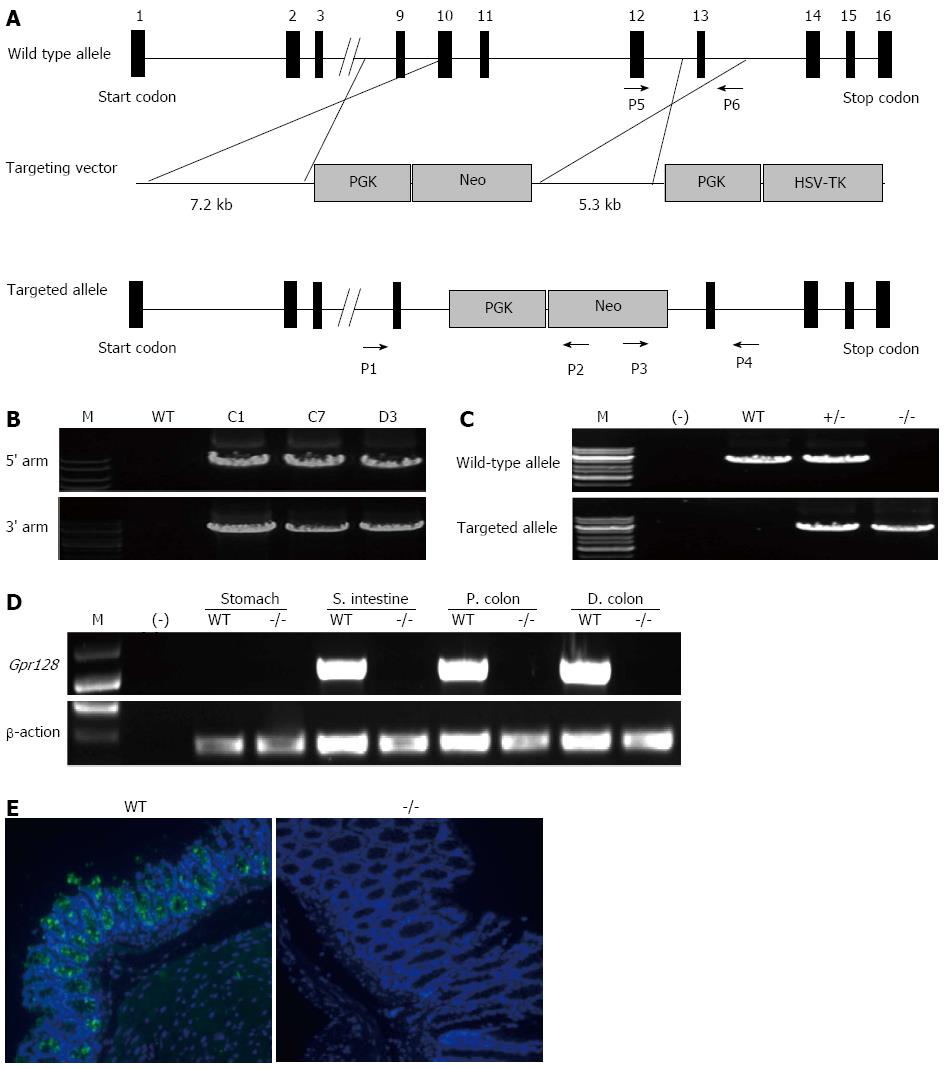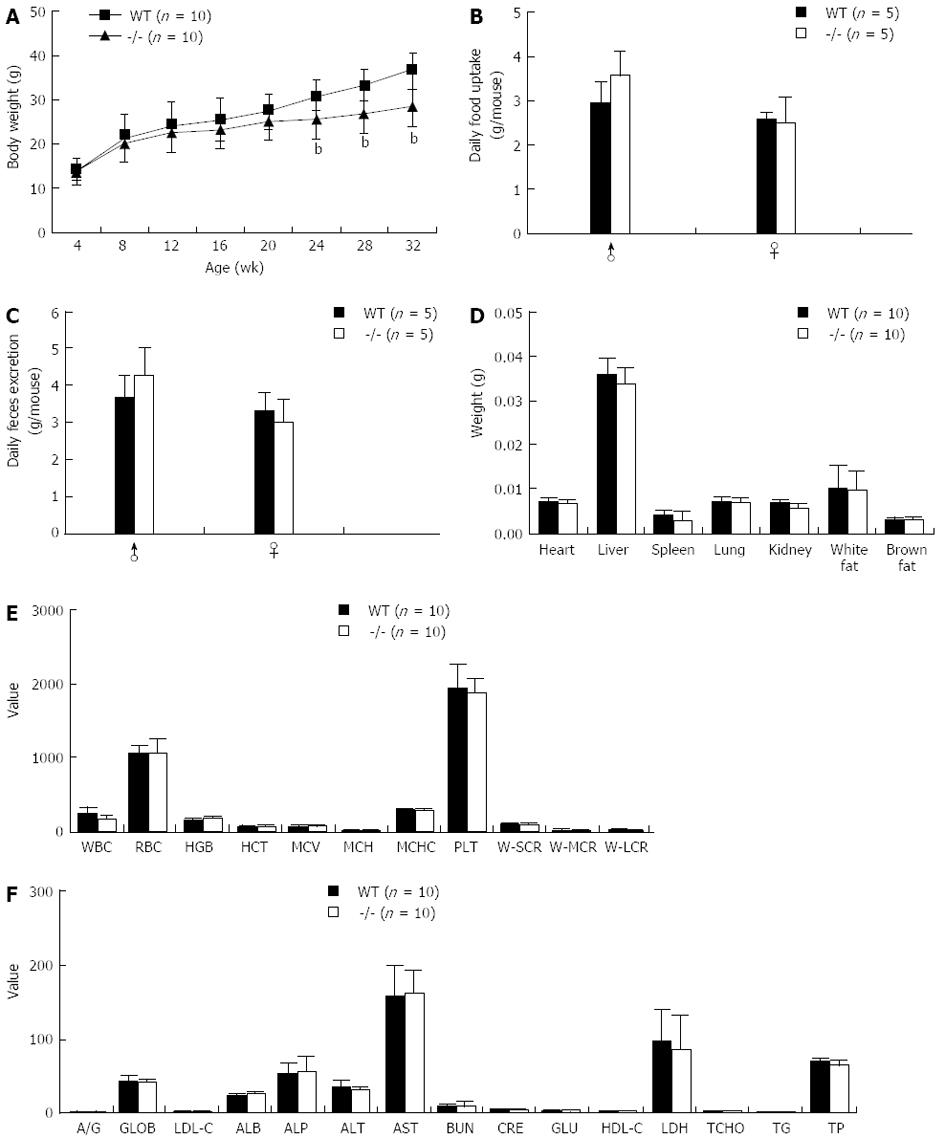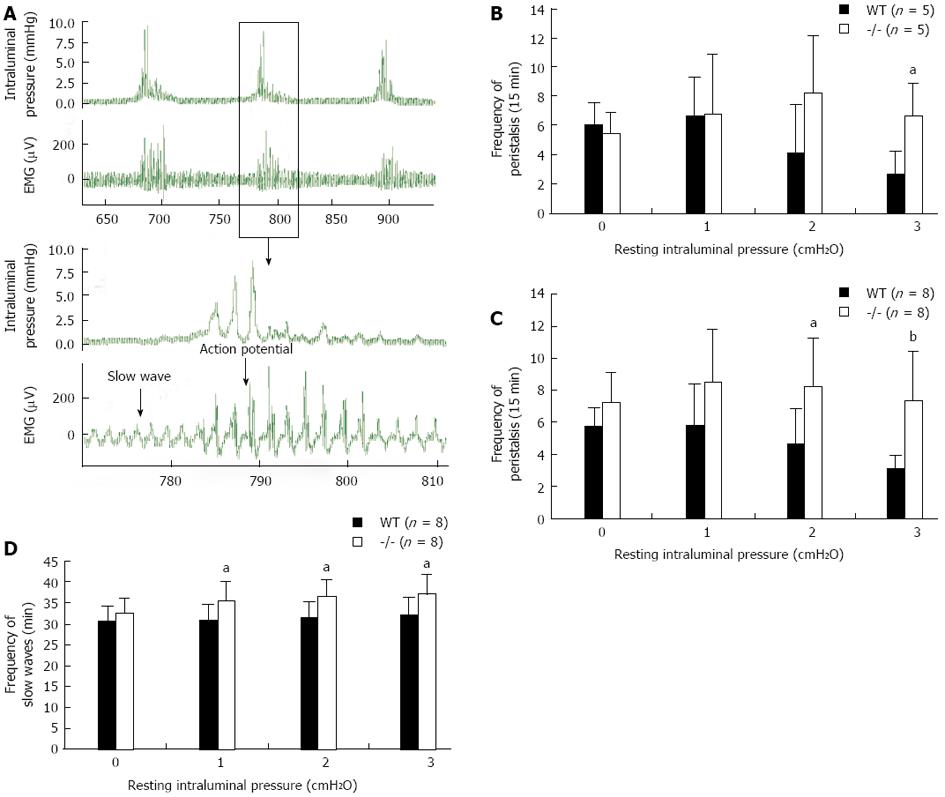Copyright
©2014 Baishideng Publishing Group Co.
World J Gastroenterol. Jan 14, 2014; 20(2): 498-508
Published online Jan 14, 2014. doi: 10.3748/wjg.v20.i2.498
Published online Jan 14, 2014. doi: 10.3748/wjg.v20.i2.498
Figure 1 Targeted deletion of Gpr128 in mice.
A: Gene targeting strategy. Numbered boxes represent Gpr128 coding exons. The start codon and stop codon are indicated as a star and pound sign, respectively. The targeting vector contains a 7.1-kb 5’ arm and a 5.3-kb 3’ arm. Exons 10, 11 and 12 of the Gpr128 gene were replaced by a PGK-Neo cassette through homologous recombination. The primer pairs for polymerase chain reaction (PCR) genotyping are indicated by arrows (5’ arm: P1, P2; 3’ arm: P3, P4); B: PCR screening for targeted embryonic stem (ES) cell clones. Correctly recombined clones show 7.7 and 5.7 kb bands, respectively. Three recombined ES cell clones show the expected bands as detected with primers P1-P4; C: PCR analysis of genomic tail DNA derived from Gpr128+/- mouse intercrossing. A 5.4-kb fragment amplified with primers P5 and P6 represents the wild-type (WT) allele. A 5.7-kb band was amplified from the targeted allele with P3 and P4; D: Gpr128 expression in gastrointestinal tissue with two different genotypes by semiquantitive reverse transcription-polymerase chain reaction. A specific Gpr128 fragment, which exists in WT mice, was deleted in Gpr128-/- mice. The transcript for β-actin was examined as a control for RNA loading and integrity; E: Expression pattern of Gpr128 protein in WT and Gpr128-/- adult mouse colon revealed by immunofluorescence (original magnification, × 200). M: Marker lane; (-): Negative control without template; S. intestine: Small intestine; P. colon: Proximal colon; D. colon: Distal colon.
Figure 2 Selective expression of Gpr128 within the intestine in mice.
A: Expression levels of Gpr128 mRNA. The mRNA levels were examined in major tissues of normal mice using semi-quantitative reverse transcription-polymerase chain reaction (RT-PCR), and the expression level of β-actin was used as an endogenous control. M: Marker lane; (-): Negative control without template; B: Northern blotting analysis of Gpr128. Total RNA from wild type mice was extracted and subjected to Northern blotting analysis using a 715-bp fragment of Gpr128 cDNA corresponding to exons 1 through 6. The bottom lane shows the 28S and 18S ribosomal RNA as a control; C: Examination of the stage-specific expression of Gpr128 mRNA. RT-PCR was performed throughout the digestive tract and at various postnatal developmental stages to determine the presence of Gpr128 mRNA from postnatal day 0 through 8 wk; D: Expression pattern of Gpr128 protein in the stomach and colon of adult WT mouse revealed by immunofluorescence (original magnification, × 200).
Figure 3 Deletion of Gpr128 results in reduced body weight gain in mice.
A: An analysis of the body weight of mice of different genotypes shows that Gpr128-/- mice have a reduced body weight (P values of weeks 24, 28 and 32 are 0.0065, 0.0010 and 0.0003); B: Daily food intake of 16-wk-old mice of different genotypes (P > 0.05); C: Daily fecal excretion of 16-wk-old mice of different genotypes (P > 0.05); D: Organs isolated from 32-wk-old animals weighed and correlated to body weight (P > 0.05); E: Blood routine test of 32-wk-old animals using an automated hematology analyzer (P > 0.05; WBC: White blood cells; RBC: Red blood cells; HGB: Hemoglobin; HCT: Hematocrit; MCV: Mean corpuscular volume; MCH: Mean corpuscular hemoglobin; MCHC: Mean corpuscular hemoglobin concentration; PLT: Platelet; W-SCR: White-small cell rate; W-MCR: White-middle cell rate; W-LCR: White-large cell rate); F: Biochemical parameters of 32-wk-old animals using an automated chemistry analyzer (P > 0.05; A/G: Albumin/globulin; GLOB: Globulin; LDL-C: Low-density lipoprotein cholesterol; ALB: albumin; ALP: alkaline phosphatase; ALT: Alanine aminotransferase; AST: Aspartate aminotransferase; BUN: Urea nitrogen; CRE: Creatinine; GLU: Glucose; HDL-C: High-density lipoprotein cholesterol; LDH: Lactate dehydrogenase; TCHO: Total cholesterol; TG: Triglyceride; TP: Total protein). All values are mean ± SD (n = 10, bP < 0.01 vs wild-type group).
Figure 4 Gpr128 deficiency leads to increased frequency of intestinal contraction.
A: The raw traces of intraluminal pressure of a jejunum segment of Gpr128-/- mice and the simultaneously recorded extracellular electrical potential from the gut wall. The lower panel of A shows an expanded view of the recording within the square of the upper panel; B: Frequency of peristalsis in wild-type (WT) and Gpr128-/- mice of 8 wk. The frequency of peristalsis was increased in Gpr128-/- mice at a resting intraluminal pressure of 3 cmH2O (n = 5, P = 0.0137); C: Frequency of peristalsis in WT and Gpr128-/- mice of 32 wk. The frequency of peristalsis was increased in Gpr128-/- mice at resting intraluminal pressures of 2 and 3 cmH2O (n = 8, 2 cmH2O: P = 0.0166, 3 cmH2O: P = 0.0020); D: Frequency of slow waves in WT and Gpr128-/- mice of 32 wk. The frequency of slow waves was increased in Gpr128-/- mice at resting intraluminal pressures of 1, 2 and 3 cmH2O (n = 8, 1 cmH2O: P = 0.0303, 2 cmH2O: P = 0.0271, and 3 cmH2O: P = 0.0402). All values are mean ± SD (aP < 0.05, bP < 0.01 vs wild-type group).
-
Citation: Ni YY, Chen Y, Lu SY, Sun BY, Wang F, Wu XL, Dang SY, Zhang GH, Zhang HX, Kuang Y, Fei J, Gu MM, Rong WF, Wang ZG. Deletion of
Gpr128 results in weight loss and increased intestinal contraction frequency. World J Gastroenterol 2014; 20(2): 498-508 - URL: https://www.wjgnet.com/1007-9327/full/v20/i2/498.htm
- DOI: https://dx.doi.org/10.3748/wjg.v20.i2.498












